The 7 Least-Faithful Comic Book Movies
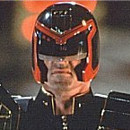
Look, Hollywood, we understand that film is a different medium than comic books. We realize that changes must be made, storylines streamlined, art design massaged. The inner nerd in us can even forgive annoying details like Peter Parker developing webbing rather than inventing it.
But, there are some films that we cannot forgive. These strike at the very core of the comic, and take everything we loved and beat them into submission with a club made of crappy CG, crappier screenplays and a whole lot of greed and apathy.
The Hulk

He wasn't.
The comic: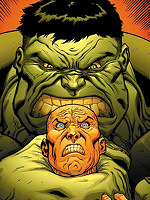 Bruce Banner gets blown up by a gamma bomb, and spends each issue turning into the Hulk and beating the shit out of military personnel and supervillains. Sometimes, he becomes king of a planet by beating the shit out of aliens.
Bruce Banner gets blown up by a gamma bomb, and spends each issue turning into the Hulk and beating the shit out of military personnel and supervillains. Sometimes, he becomes king of a planet by beating the shit out of aliens.
The movie:
The movie spends an inordinate amount of time developing the character of the Hulk's dad (David Banner) and in general plods along for an hour before the Hulk appears and punches stuff. David Banner winds up as both the film's main villain and the second-craziest public appearance ever turned in by Nick Nolte.
David Banner's dangerous experiments on himself, combined with Bruce's being bombarded with gamma radiation and some nanobots thrown in for good measure (read: "no reason") result in his turning into The Hulk.
Why did they change it?
There seemed to be a real effort to make this comic book movie psychologically cogent and scientifically realistic (The Hulk is now the result of some kind of genetic nanobot tampering). The award-winning Ang Lee apparently saw a comic with Hulk body slamming a 747, screaming "HULK SMASH" and decided this would be a good vehicle to delve into psychological themes about what it means to be human.

Did it work?
It almost worked, until a the giant mutant dogs showed up. Sure, they gave the Shrek-like CGI Hulk something more fake-looking then himself to fight, but that didn't stop them from being totally and pointlessly retarded.

Word-of-mouth for the movie was so awful that it holds a record for biggest drop in ticket sales after the opening weekend. That's the Hollywood equivalent of running in a touchdown on the first play of the Super Bowl, and then having your pants fall down on every subsequent play.
But, if nothing else, the movie should be credited for pioneering that wicked picture-in-picture technique that has since been used in a number of comic book films. And it helped administer the final deathblow to Nick Nolte's film career, freeing him up for much more entertaining activities. But, nothing will ever make up for those retarded mutant dogs.
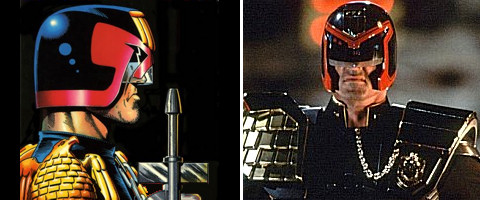
Sylvester Stallone plays Judge Joe Dredd, sociopathic administrator of future justice who must face mutants, lawless citizens, a crazy cloned brother, corrupt officials, owning only one outfit (which has a gold eagle's head on the right shoulder), and having a ridiculous accent. He faces these things by shooting them.
The comic:
Comic book Judge Dredd was an abstract figure, a Dirty Harry-esque symbol that allowed his (British) creators to lampoon and analyze totalitarianism, fascism, complex legal issues and ironically dissect the archetypal violent American action hero.

Stallone, famous for roles where he beats people unconscious and kills them with hunting knives, predictably focused more on the "archetypal violent American action hero" part, and left out the irony.

The character in the comic is never unmasked (emphasizing the "abstract figure" thing) but, when producers are paying $10 million to get Sylvester Stallone in their movie, they're going to want to see that piercing gaze and gorgeous saggy lip of his in all its glory, so the mask came off. That gives you an idea that this was no a Judge Dredd movie and was in fact a Sylvester Stallone movie.
Why did they change it?
In 1995, the ratio of Sylvester Stallone fans to Judge Dredd comic fans was about 1 million to 0. So, Judge Dredd simply became a costume for Sly to wear.

Did it work?
Judge Dredd's original comic, 2000 AD, and his huge catalog of subsequent comic series, spinoffs and trade paperbacks are complex and influential enough that he's still brought up in Britain during debates about issues like police states and rule of law. In America, Judge Dredd is usually only brought up when you and your roommates are bored on a Wednesday night and keen to invent a new drinking game. Here's a good one: Drink every time Dredd says, "How do you plead?" "I knew you'd say that" or screeches the word "law" while spit flies from his distended mouth. You'll all be getting your stomachs pumped within 20 minutes.
The story behind the comics, as it turns out, doesn't work after you strip out every element except for the name of the character. The movie cost $90 million to make and grossed $35 million in the United States.
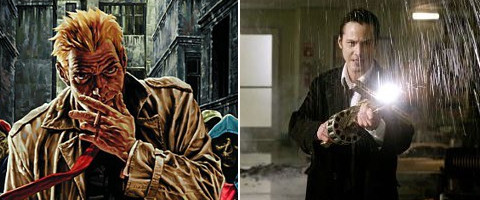
Keanu Reeves plays a man in a black trench coat chosen by fate to uncover the shocking truth that Earth is not as we believe it to be, but merely a mundane illusion hiding an army of insidious and overwhelming enemies. So, basically, it's The Matrix with crosses.
The comic:
In the comic (called Hellblazer), John Constantine is a foul-mouthed con man who exploits the forces of both heaven and hell, using dirty tactics and minimal supernatural abilities to foil chumps of all shapes and sizes.

The movie:
In the movie, he's a repentant Catholic destroying demons to save the soul of a little girl and earn his way into heaven. Keanu apparently requires all of his characters to fulfill the "savior" role to a spectacular degree. We're surprised Bill & Ted's Excellent Adventure didn't contain a scene where Ted travels to Jesus' time and, in some kind of wacky mix up, dies for all our sins.
Like the comic, the movie revolves around Constantine trying to get demons to cure his lung cancer. But, after he succeeds in the movie, John quits smoking. Come on! You've just annoyed Satan into magically taking away your lung cancer and you're quitting smoking?! Your lungs are magic! If anything, you should start smoking four or five cigarettes at a time with the filters ripped off and the tips dipped in ether.
Why did they change it?
Say what you want about comics, but they've got Hollywood beat when it comes to the whole moral-ambiguity thing. Keanu's Constantine has just enough token flaws to be cool, and, in true Hollywood fashion, loses them all by the time the movie ends.

Strangely, though, losing everything that was fun about the comic book character wasn't enough. They also changed a bunch of small, arbitrary stuff, like the pronunciation of his name (in the movie rhymes with "tangerine" instead of "turpentine"), made him American instead of British, and did very little to make Reeves look like Sting, who was the original inspiration for the character. If that much needed changed, why adapt it at all?
Did it work?
Alan Moore, Constantine's creator, hated the movie so much he asked his name to not be put in the credits. Of course, he's done that with every movie made of his work, and at some point you have to wonder if he's just being a drama queen. The guy does wear a good number of oversized rings, and sports a beard large enough to house a family of raccoons. He clearly likes to be looked at.

That still doesn't mean Constantine didn't suck.
The Mask
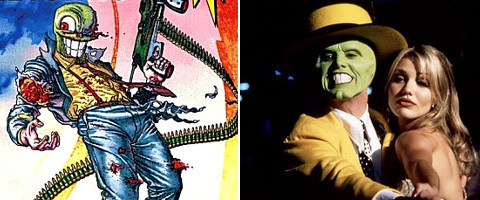
Jim Carrey discovers a magical mask that allows his face to become slightly more elastic than it already is, and uses this ability to reenact as many moments from old Tex Avery cartoons as is humanly possible within a two-hour period.
The comic: In the comics, the green-headed character is not, in fact, named The Mask. His name is Big Head, and rather than humiliating villains by pantsing them in front of their henchman, he mercilessly kills anyone that the mask's wearer dislikes and indulges in his every id-driven whim. The main character (Stanley Ipkiss) kills some people who don't deserve it, is verbally abusive to his girlfriend, then gets shot in the back and killed.
In the comics, the green-headed character is not, in fact, named The Mask. His name is Big Head, and rather than humiliating villains by pantsing them in front of their henchman, he mercilessly kills anyone that the mask's wearer dislikes and indulges in his every id-driven whim. The main character (Stanley Ipkiss) kills some people who don't deserve it, is verbally abusive to his girlfriend, then gets shot in the back and killed.
The cop who's after Ipkiss (Lt. Kellaway) eventually puts on the mask himself and goes on a murderous rampage, nearly kills his partner and flees in horrified shame.
The movie:
Stanley becomes a lovable loser who pursues the woman of his dreams and ultimately uses the powers of The Mask to thwart an organized crime boss. Wackiness ensues.
Lt. Kellaway turns into your basic gruff, overweight policeman doing a lot of exasperated takes at the ends of scenes and yelling at his dim-witted partner. The film gracefully adapts Kellaway's violent rampage into a scene where the Mask yells "AHOOGA!," lifts Kellaway's shirt and blows on his belly.

Why did they change it?
As with Judge Dredd, the little-known comic became a vehicle for a Hollywood star who completely overpowered it. Carrey hadn't moved into the brooding, dramatic phase of his career yet and used The Mask as an excuse to play a zanier Ace Ventura.
Did it work?
In the comics the contrast between a cartoon character and realistic acts of mayhem is a little easier to swallow since, well, everyone is a cartoon character. On film, you kind of have to pick: Either your character is a murdering badass, or a shape-changing wiseacre. They went with the latter and wound up with one of Carrey's more entertaining early films.
Fans of the comic were no doubt outraged, but any attempt to play it straight could have resulted in the same off-putting combination of CGI and pathos that Hulk turned out to be.
Superman III

The comic:
In the comics, Superman faces foes equal to his power: Metallo, Apocalypse, Doomsday, what have you. In Superman III, he fights Ross Webster, a guy who's basically a weaker, dumber Lex Luthor with a supercomputer. Webster's nefarious plans? To monopolize the world's coffee supply! Yes, really.
The movie:
One would think that movie executives would realize that people who buy tickets to a movie titled Superman are interested in seeing a movie about Superman. One would overestimate movie executives. A good chunk of the movie is dedicated to following the wacky hijinx of Gus Gorman, a bumbling computer whiz played by the late Richard Pryor.

Not that Pryor isn't hilarious and everything, but we go to Superman movies to see flying, space fighting and laser eyes, not racially-charged underground satirists getting their material whitewashed.
At one point in the movie, Webster sends some chunks of kryptonite to Superman, which causes him to split into an evil Superman and a good Clark Kent, who then duke it out in one of the shallowest passes at Freudian psychology ever put to film.

Technically, this never happened in the comics, although to be fair the comics have had different forms of kryptonite make superman fat, an ant, and gay, so you can't really fault the filmmakers for doing whatever the hell they want here.
Why did they change it?
Gene Hackman (Lex Luther) reportedly refused to be in the film due to a dispute with the producers. Meanwhile, Richard Pryor was coming off a string of hits and the producers figured he'd make a nice replacement. It was kind of like finding out you have no milk for your cereal, and using bourbon instead.
Did it work?
Let's face it, most of the original Superman movies had something fundamentally wrong at their core: Number four inexplicably made him telekinetic, and the original had him turning back time by changing the rotation of the earth, which isn't an affront to Superman canon so much as it is an affront to anyone who's taken a High School physics course.
But Superman III was unfaithful in the worst way possible, in that it wasn't really even about Superman. It's a sad day when you're watching Superman and Clark Kent battle, and find yourself hoping the three kryptonians from the second movie will bust out of the phantom zone and kill them both.
Howard the Duck

A 4-foot tall anthropomorphic duck is brought to Earth and must defeat an evil, demon-possessed scientist while courting human female Beverly Switzler, thus finally bringing bestiality into the cultural mainstream.
The comic: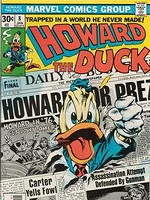 In the Marvel comics, Howard was a cynical misanthrope trying to get home while battling enemies with names like Dr. Bong. In the comics, Howard interacts with Marvel characters like Spider-Man, Ghost Rider and She-Hulk. Howard knew he was a comic book character and commented on it frequently, in what can be described as meta-conscious genre-specific satire, if you're a pompous ass.
In the Marvel comics, Howard was a cynical misanthrope trying to get home while battling enemies with names like Dr. Bong. In the comics, Howard interacts with Marvel characters like Spider-Man, Ghost Rider and She-Hulk. Howard knew he was a comic book character and commented on it frequently, in what can be described as meta-conscious genre-specific satire, if you're a pompous ass.
The movie:
In the movie, all that satirical meta-humor is replaced by lots of puns involving the word "duck." LOTS. Permutations of the word "duck" comprise a good sixty percent of Howard's dialogue. Howard is never aware he is a character in a film, let alone a shitty one, which is too bad because we can easily imagine Howard walking out, finding the theater's manager and clamping his bill squarely onto the man's testicles.
Why did they changed it:
The movie was to be rated PG, meaning they had to both dumb it down and walk a weird line between the kiddie audience and the comic's racy humor. Thus, Beverly Switzler, the only character other than Howard who appeared in both the comic and the movie, was a nude art model in one medium and a musician in the other. Can you guess which is which? HINT: The movie was rated PG, and people who read comics are horny almost all the time.

Did it work?
The film was one of the worst things to ever exist on Earth. It was the first adaptation of a Marvel comic, and it set the bar so low that it melted from the heat of the planet's core. Howard the Duck lost $21 million, and has gone down in movie history as one of George Lucas' four biggest mistakes.
Batman and Robin

The comic: Mr. Freeze is a frail, calculating scientist using his intellect to try and revive his cryogenically frozen wife. Bane is an unstoppable juggernaut who releases the inmates of Arkham Asylum, plays Gotham City like a game of chess, and finally breaks Bruce Wayne's spine, paralyzing him.
Mr. Freeze is a frail, calculating scientist using his intellect to try and revive his cryogenically frozen wife. Bane is an unstoppable juggernaut who releases the inmates of Arkham Asylum, plays Gotham City like a game of chess, and finally breaks Bruce Wayne's spine, paralyzing him.
The movie:
Mr. Freeze yells "Chill out!" Then he freezes people. We hope you're getting the modus operandi here, because they couldn't have made it much clearer. Unless of course they went with the initial character design, which featured a sign on Freeze's chest reading "You gonna get frozen! By me! Mr. Freeze!" Bane is relegated to the role of Poison Ivy's bodyguard and occasionally grunts to signal that he needs to use the restroom.
The dark themes and shadows of the comic were replaced by sets with enough DayGlo paint to completely recreate the 1980s. No one in the comic ever did a choreographed flip off of a Gotham City building mysteriously shaped like a roller-blade ramp. Except once, but that guy got the shit beat out of him.
In the comics, Batgirl is the daughter of Commissioner Gordon. In the movie, BATMAN HAD RUBBER NIPPLES.

Why did they change it?
The previous film, Batman Forever was the first to take the lighter, goofier tone (complete with red neon lights on the bad guys' tommy guns) and it made truckloads of money. The studio figured, well, that worked, so ...
Did it work?
Batman and Robin isn't just bad by comic book standards, it's bad by the standards one applies to getting hit in the face with a festively-decorated baseball bat. The filmmakers' crass attempt at a two-hour toy commercial rightly failed, and tragically took Alicia Silverstone's career with it. The nonstop defiling of the character was enough to make any Batman fan develop an instinctual aversion to George Clooney, an aversion that wouldn't dissipate until well after Three Kings.
How bad was it, really? Even Joel Schumacher thinks it sucked. If you listen to the director's commentary track on the DVD, it's essentially one long, repeated apology. But please, don't buy the DVD; just root through someone's dumpster until you find a copy. We don't want to support this kind of behavior.
Michael writes and performs for sketch troupe Those Aren't Muskets!